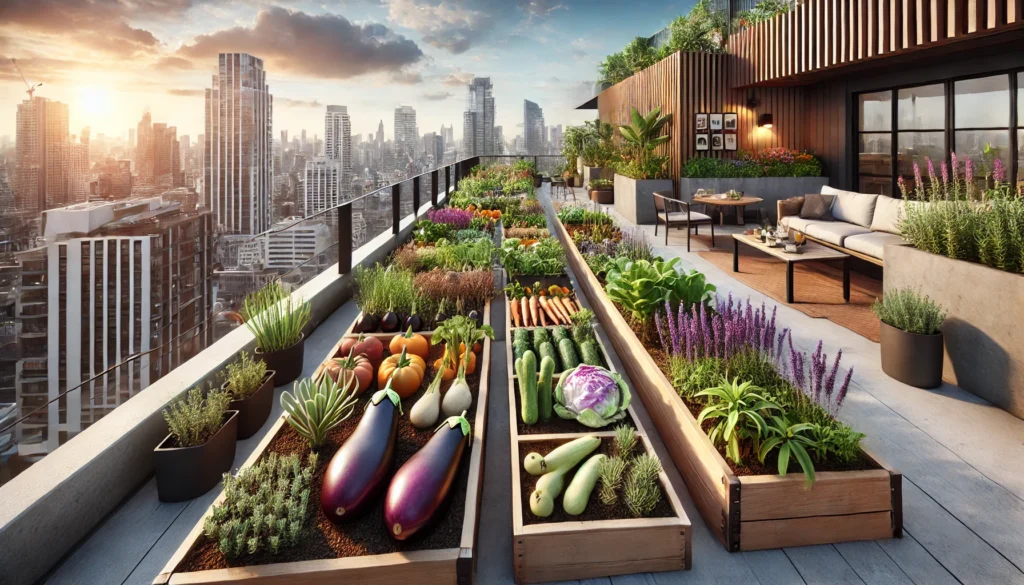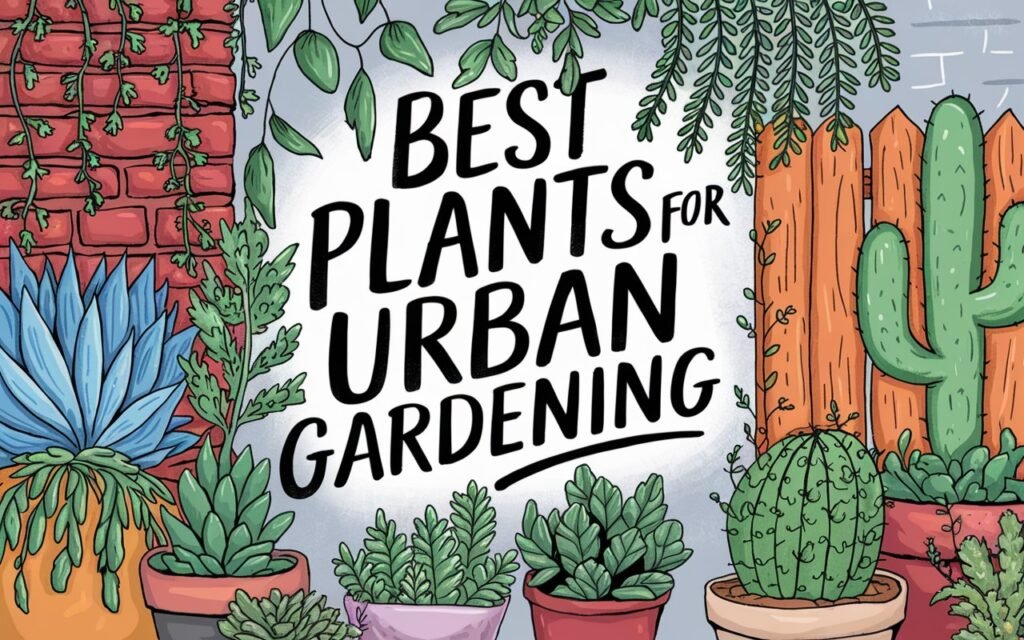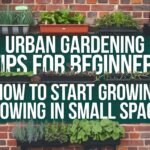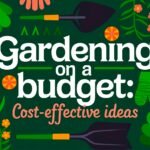Introduction
Urban gardening is changing the way people in cities interact with nature. With the increasing expansion of the city The demand for green space has therefore increased significantly. Urban gardening allows individuals to bring plants into their homes. Improve the quality of the garden and grow fresh fruits and vegetables in compact spaces. However, limited space, pollution, and lack of sunlight can challenge traditional gardening in urban environments. That is why choosing the best plants for urban gardening is so important to a thriving garden. It is low maintenance. and provides worthwhile returns
This article explores plant ideas for urban spaces. Useful tips for care and sustainable ways to ensure your garden blooms year-round.
Understanding Urban Gardening
Definition of Urban Gardening
Urban gardening is cultivating plants in confined spaces, such as towns and villages. It can take many forms, such as balcony gardens, terraced gardens, indoor environments, or even a vertical garden. This practice combines innovation with sustainability. It allows city residents to grow vegetables even if they have limited space.
Benefits for the Environment and Individuals
Urban gardening has many advantages:
- Environmental Benefits: Reduced carbon emissions. Improve air quality and reduce the impact of heat waves in the city.
- Personal Benefits: Gardening provides fresh produce. Improve mental health and promote success It can also be a therapeutic hobby, reduce stress, and promote relaxation.

Factors to Consider When Choosing the Best Plants for Urban Gardening
Space Constraints
Urban gardens generally have limited square footage. Opt for compact, versatile plants that thrive in small spaces. With vertical gardening or using hanging containers. I can maximize the available space.
Climate and Sunlight Availability
Provides solar illumination to your space A south-facing balcony will get plenty of sunlight. Suitable for most vegetables Meanwhile, shaded areas may require low-light plants such as samba and cobra.
Maintenance Needs
Some plants require watering. pruning and frequent care Choose a low-maintenance option if you have a new garden planned or agenda.
Choose Best Plants for Urban Gardening
Herbs
These fragrant herbs are perfect for small balconies. Because of its portability and versatility, the kitchen. Great options include:
- Basil: Thrives in sunny locations and adds flavor to many dishes.
- Mint: proliferates and requires minimal maintenance.
- Thyme: A tough herb that grows well in small containers.
Compact Vegetables
The following vegetables can be grown in small spaces:
- Cherry Tomatoes: Great for containers. They thrive with enough sunlight.
- Peppers: Come in a range of hues and tastes.
Vertical Gardening Plants
Vertical gardening is a technique that saves space and works wonders in an urban environment.
Climbing Vegetables
- Cucumbers: Grows well on a trellis. High yield in a small area.
- Beans: Easy to grow, high-yielding, vertical.
Flowering Vines
- Morning Glory: A fast-growing trail that adds color to vertical spaces.
- Clematis: Elegant flowers that brighten up walls and trellises.

Container Gardening Favorites
Container gardening provides flexibility. This allows plants to grow in different-sized containers.
Edible Options
- Lettuce: It multiplies and can be cold several times.
- Spinach: A leafy, nutrient-rich vegetable that thrives in shallow containers.
ornamental plant.
Ornamental Plants
- Petunias: Bright, cheerful flowers that bloom in abundance.
- Begonias: Versatile and listed for shaded areas.
Indoor-Friendly Plants
Indoor gardens are ideal for city apartments that lack outdoor space.
Low-Light Edibles
- Mushrooms: Easily grown in low light and humidity conditions.
- Microgreens: Need minimal sunlight and grow quickly.
Air-Purifying Plants
- Snake Plant: Almost indestructible and improves air quality.
- Pothos: Indirect light is ideal for this creeping plant.
Best Plants for Rooftop Gardens
Indoor gardens get lots of sunlight. However, it might be exposed to heat and wind.
Hardy Vegetables
- Zucchini: A prolific plant that adapts to dry conditions.
- Eggplants: Grows well in containers and is heat tolerant.
Drought-Tolerant Choices
- Lavender: Adds a pleasant aroma and grows well in dry conditions.
- Succulents: Great for warm, sunny outdoors with minimal water requirements.
Low-Maintenance Urban Plants
For gardeners who have limited time Choose plants that require the least care.
- Cacti and Succulents: Great for beginners who need frequent watering.
- Perennial Herbs: Options like oregano and alecum are hardy and produce year-round.
Seasonal Gardening Tips
Gardening success depends heavily on understanding seasonal variations. Each season offers special occasions or the cultivation of specific crops.
The Greatest Summer Plants to Pick for Urban Gardening
during the summer The heat and long hours of the day are ideal for growing cultural plants and flowers in hot climates. Consider:
- Tomatoes: Grows in direct sunlight and produces plentiful tubers.
- Zinnias: Brightly colored flowers that bloom in abundance I will never see.
- Basil: Grows quickly and goes well with summer dishes.
Winter Gardening Ideas
Winter doesn’t mean you have to put off gardening. Many plants bloom in cooler temperatures:
- Kale: Geada durable and durable Great for salads and smoothies.
- Pansies: Cold-tolerant flowers that warm the winter garden.
- Garlic: Plant in late fall to give Colheita a hardy spring.
How to Maximize Yield in Urban Spaces
Companion Planting
Companion plants encapsulate or grow a set of plants that benefit each other. For example:
- Tomatoes and Basil: Manjericão repels pests such as aphids and increases tomato growth.
- Carrots and Onions: Onions catch Cenoura flies, while Cenouras kill only when the onion is growing.
Soil and Fertilizer Optimization
Urban gardens often lack rich nutrients. Improved fertility:
- Using high-quality packaging mix or compost.
- Apply an organic fertilizer such as Osso’s flour or Peixe emulsion.
- Circulating cultures to maintain health alone.

Sustainable Gardening Practices
Urban gardeners have the opportunity to create environmentally conscious schools.
Composting at Home
Convert kitchen scraps into compost that is high in nutrients for your plants (learn how to compost at home). Fruit peels, vegetable scraps, and coffee grounds easily decompose in small containers.
Water Conservation Techniques
- Use a drip irrigation system to reduce or wastewater.
- Collect water from Chuva and put it in a bucket to water the plants.
- Group plants with similar water levels to increase moisture.
Overcoming Common Challenges
Gardening in the city has its challenges. But it can be fixed with a well thought out solution.
Pest Control in Small Gardens
Fight like Prague effectively:
- Aphids can be managed by introducing natural predators like joaninhas.
- Use organic sprays containing neem oil or alcohol.
- To save trees, put up physical barriers like netting.
Dealing with Limited Sunlight
If your city has no solar light:
- Choose shade-tolerant plants such as sampayas, pothos, or alfas.
- Use crop lights to complement natural light. especially indoor gardens
- To guarantee that the plant receives uniform light, rotate the container on a regular basis.
Tools and Accessories for Urban Gardening
Certain types of furniture can make gardening more efficient and enjoyable.
Essential Tools for Beginners
- Trowel: for planting and digging small holes.
- Pruners: To prune the tree and maintain its shape.
- Watering Can: A few options for small spaces.
Advanced Equipment for Enthusiasts
- Vertical Planters: Maximize your space with a multi-bed planter.
- Self-Watering Pots: Reduces the need for daily watering.
- Soil Moisture Meter: Make sure plants are adequately watered.
Conclusion
Urban gardening is a fee-effective way to deliver greenery and sustainability to city existence, through deciding on the excellent flora for urban gardening. You can overcome space limitations. Enjoy sparkling culmination and veggies. And create a tranquil retreat in your property.
With proper care creativity and sustainable practices, Your urban garden will thrive all year round. Then he peeled off his Colete a Ferramenta sleeve and started planting today!
Let’s start your urban garden >>>>>
FAQs of Best Plants for Urban Gardening
1. How do I start urban gardening?
Start by evaluating your space, sunlight, and weather conditions, choosing plants that are appropriate for your conditions. Gather the necessary iron. And start with easy planting options like herbs or green foliage.
2. Which plants grow best in low sunlight?
Plants which includes samba, cobra, and pothos once in a while thrive in low-light conditions. This makes it best for shaded urban regions.
3. What are the perfect flowers for novices?
Beginners can start with low-maintenance plant life inclusive of cauliflower, lawn flora, succulents, or malmegueres. They require little protection and are forgiving of errors.
4. How can I develop flora in restrained space?
Maximize your area with the aid of the use of vertical gardening techniques, striking vases, or more than one plant beds. Select little flora like microgreens or cherry tomatoes.
5. What are the benefits of developing food at domestic?
Homegrown food is clean. More nutritious and loose from harmful chemicals It also reduces haberdashery fees and promotes a sustainable life-style.
6. Are there particular vegetation for air purification?
Additionally, air-purifying flowers which includes cobra plant, pothos plant, peace lily, and aranha plant are first rate picks for enhancing indoor air pleasant.




Pingback: Vertical Gardening Ideas for City Dwellers - Green Leaf Path